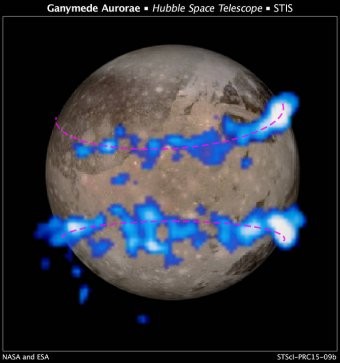NASA Finds Vast Underground Ocean on Jupiter's Moon, Ganymede
| Marco Foronda | | Mar 13, 2015 08:12 AM EDT |
(Photo : NASA/ESA) NASA Hubble Space Telescope shows images of Ganymede's auroral belts (colored blue in this illustration).
NASA has again announced life must have had at least a shot at getting going on an astral body other than Earth.
Scientists made a pair of seven-hour long ultraviolet observations of Ganymede, Jupiter's largest moon, with the goal of capturing the moon's brightly glowing aurora.
Like Us on Facebook
The moon, which is larger than the planet Mercury, is known to have a magnetic field, a discovery made by NASA's now-defunct Galileo spacecraft. The moon also is embedded in the much larger magnetic field of its parent planet, Jupiter.
The latest evidence comes from the Hubble Space Telescope that observed Ganymede's magnetic field for a glimpse of its interior. The workhorse telescope studied changes in colorful auroras in the moon's Polar Regions produced by its magnetic field to determine the existence of an ocean lurking underneath.
"Scientists estimate the ocean is 60 miles (100 kilometers) thick -- 10 times deeper than Earth's oceans -- and is buried under a 95 mile (150 kilometer) crust of mostly ice," NASA added.
Without an ocean, Ganymede's aurora would rock six degrees because of Jupiter's magnetic pull. Instead, it shifts by just 2 degrees.
The news comes on the heels of a finding earlier this week that Saturn's moon Enceladus may contain enough warm water to support life. Ganymede is now more competitive when it comes to garnering attention among the Jovian moons.
Its sibling Europa and its presumed subsurface ocean have long excited space geeks, even working its way into the priority list for future NASA missions.
Ganymede is one of about five dozen moons circling Jupiter. It's the largest moon around the giant planet and the biggest moon in the solar system.
With a diameter of 3,270 miles, it's slightly larger than the smallest planet, Mercury. It was discovered in 1610 by Galileo, who called it Jupiter III. It was later named after Ganymede, a Trojan prince in Greek mythology.
The European Space Agency is planning to launch an eight year-long mission to Jupiter in 2022.
TagsNASA Finds Vast Underground Ocean on Jupiter's Moon Ganymede, jupiter moon, Ganymede, moon, Universe, Milky Way, space exploration, ESA, NASA, Hubble Space Telescope, Magnetic Field, Ganymede's auroral belts
©2015 Chinatopix All rights reserved. Do not reproduce without permission
EDITOR'S PICKS
-

Did the Trump administration just announce plans for a trade war with ‘hostile’ China and Russia?
-

US Senate passes Taiwan travel bill slammed by China
-

As Yan Sihong’s family grieves, here are other Chinese students who went missing abroad. Some have never been found
-

Beijing blasts Western critics who ‘smear China’ with the term sharp power
-

China Envoy Seeks to Defuse Tensions With U.S. as a Trade War Brews
-

Singapore's Deputy PM Provides Bitcoin Vote of Confidence Amid China's Blanket Bans
-

China warns investors over risks in overseas virtual currency trading
-

Chinese government most trustworthy: survey
-

Kashima Antlers On Course For Back-To-Back Titles
MOST POPULAR
LATEST NEWS
Zhou Yongkang: China's Former Security Chief Sentenced to Life in Prison

China's former Chief of the Ministry of Public Security, Zhou Yongkang, has been given a life sentence after he was found guilty of abusing his office, bribery and deliberately ... Full Article
TRENDING STORY

China Pork Prices Expected to Stabilize As The Supplies Recover

Elephone P9000 Smartphone is now on Sale on Amazon India

There's a Big Chance Cliffhangers Won't Still Be Resolved When Grey's Anatomy Season 13 Returns

Supreme Court Ruled on Samsung vs Apple Dispute for Patent Infringement

Microsoft Surface Pro 5 Rumors and Release Date: What is the Latest?










